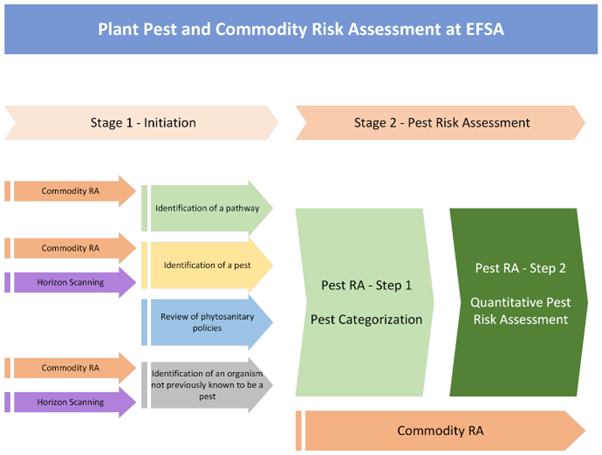Risk assessment for plant pests
One of the key tasks of our expert Panel on plant health is to conduct risk assessments of emerging and established plant pests, and of threats to food commodities.
Our experts assess for example whether plant pests should be considered for inclusion in the European Union's (EU) list of quarantine pests According to Regulation (EU) 2016/2031, a pest is a ‘quarantine pest’, with respect to a defined territory, if it fulfils all of the following conditions:(a) its identity is established;(b) it is not present in the territory or, if present, is not widely distributed within that territory;(c) it is capable of entering into, becoming established in and spreading within the territory, or, if present in the territory, but not widely distributed, is capable of entering into, becoming established in and spreading within those parts of that territory where it is absent;(d) its entry, establishment and spread would have an unacceptable economic, environmental or social impact on that territory, or, if present but not widely distributed, for those parts of the territory where it is absent; and(e) feasible and effective measures are available to prevent the entry into, establishment in or spread of that pest within, that territory and to mitigate the risks and impact thereof., requiring specific control and surveillance activities, and to advise on risk mitigation options.
Our assessments support EU legislators in their decisions on measures to protect plant health.

Pest categorisation
Pest categorisation is the first stage of a risk assessment A specialised field of applied science that involves reviewing scientific data and studies in order to evaluate risks associated with certain hazards. It involves four steps: hazard identification, hazard characterisation, exposure assessment and risk characterisation, in which we describe a pest's identity, biology, distribution, regulatory status, host range, and its ability to enter, establish and spread in the EU.
The categorisation also establishes whether the pest meets the criteria to be considered as a quarantine pest (absence or limited presence in the EU but with the ability to enter, establish and spread) or a regulated non-quarantine pest (already present in the EU).
Quantitative risk assessment
If our experts conclude that a pest A living organism (e.g. an insect, rodent, weed, fungus or virus) that is harmful to plants and/or their products (e.g. seeds, fruits) meets the criteria to be considered a quarantine pest, the European Commission may decide to request us to conduct a quantitative risk assessment, including an evaluation of risk reduction options and current EU control measures.
In our assessments we look at the risk of the introduction and subsequent spread of a new pest, and their impact in the EU. We also compare the consequences of a combination of measures currently in place to reduce the phytosanitary risk.
Priority pests
EU rules require the establishment of a list of pests that could have significant economic, environmental or social consequences, known as priority pests. The list guides EU Member States in preparing measures to control and manage the risks posed by these pests.
The first list of 20 priority pests was established based on an analysis of criteria and indicators carried out by the European Commission's Joint Research Centre (JRC), and risk assessments provided by EFSA.
This list includes pests such as Xylella fastidiosa, the Japanese beetle (Popillia japonica), the Asian long-horned beetle (Anoplophora glabripennis), citrus greening and citrus black spot.
The methodology developed by the JRC and EFSA allows for pests to be assessed quantitatively and ranked according to the severity of the threat they pose.
The results show, for example, that the bacterium Xylella fastidiosa could cost the agricultural sector over €5.5 billion per year in lost production, if it were to spread across the entire EU.
Similarly, if the Asian long-horned beetle were to spread across the EU, the cost to the forestry sector could be as high as €50 billion per year.
EFSA is assessing new potential candidates to join the list of priority pests. We are working together with the JRC and expect to publish our assessments by the end of 2024.
Commodity risk assessment
As required by the EU’s plant health law, the European Commission drew up a list of high-risk plants, i.e. plants that pose a pest risk of unacceptable level for the Union territory, that are banned from introduction into the EU.
Our experts assess the threats posed by the plants on this list to support the European Commission in deciding whether to update the list.
Before starting this work in 2019, we published a report outlining the information third countries need to provide when challenging the validity of EU import restrictions on a plant or plant product.
We also produced guidance explaining the methodology we use when carrying out these assessments.
An infographic is also available to visually illustrate how the EU makes sure that imported plants are safe.
Our experts also assess the risk that plant pests pose to a specific commodity imported into the EU, or the efficacy How well something works in relation to predefined standards or expectations of measures taken by an exporting country to prevent or reduce the risk to plant health in the EU.
Published on this topic
Expert group

Experts in pest risk assessment, plant pathology, epidemiology, and ecology.